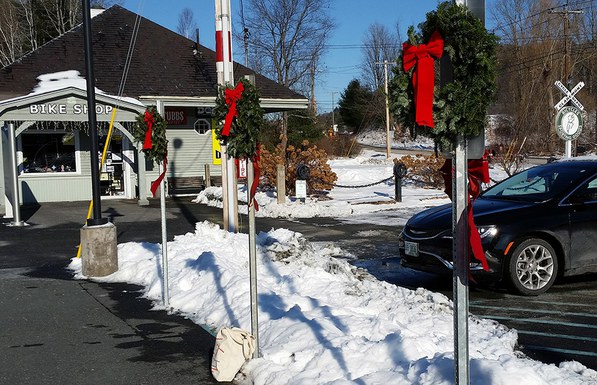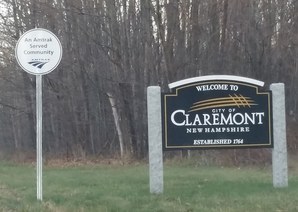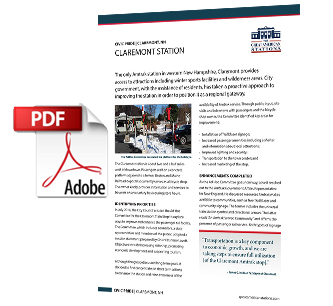The only Amtrak station in western New Hampshire, Claremont provides access to attractions including winter sports facilities and wilderness areas.
City government, with the assistance of residents, has taken a proactive approach to improving the station in order to position it as a regional gateway. The Claremont station is about two and a half miles west of downtown. Passengers wait on a concrete platform with a passenger shelter adjacent to a former Boston and Maine Railroad depot that currently serves as a bicycle shop.
Identifying Priorities

The Ad Hoc Committee for the Claremont Train Stop decorated the platform for the holidays.
In July 2014, the City Council created the Ad Hoc Committee for the Claremont Train Stop to explore ways to improve and enhance the passenger rail facility. The Committee, which includes councilors, a state representative and members of the public, adopted a mission statement prepared by Chair Charlene Lovett. Objectives include increasing ridership, promoting economic development and supporting tourism.
Although the group discussed long term goals, it decided to first concentrate on short term actions to enhance the station and raise awareness of the availability of Amtrak service. Through public input, site visits and interviews with passengers and the bicycle shop owner, the Committee identified key areas for improvement:
- Installation of Trailblazer signage;
- Increased passenger amenities including a shelter and information about local attractions;
- Improved lighting and security;
- Transportation to the town center; and
- Increased marketing of the stop.
Enhancements Completed
As the Ad Hoc Committee got underway, Lovett reached out to the Amtrak Government Affairs Representative for New England. He discussed resources Amtrak makes available to communities, such as free Trailblazer and community signage. The former includes the universal train station symbol and directional arrows. The latter reads “An Amtrak Served Community” and affirms the presence of passenger rail service. Both types of signage were installed throughout the city in fall 2014.

New community signage (left) highlights Amtrak service.
That December, the town initiated a one-year pilot program to extend an existing Community Alliance Transportation Services (CATS) bus route to the station. It met the southbound Vermonter on weekday mornings.
Committee members reached out to the Vermont Agency of Transportation, which has state oversight of the Vermonter service, to detail their efforts. They also spoke to the local chamber of commerce, New Hampshire Passenger Rail Authority, Upper Valley Lake Sunapee Regional Planning Commission, local businesses and regional media to promote the improvement plans and solicit feedback.
Looking to the Future
The Committee explored the installation of an enclosed passenger shelter, which was dedicated in October 2015. It protects passengers from inclement weather and provides bench seating. Local businesses donated the material, and volunteers contributed their time and labor. The Committee also monitored the introduction of carry-on bike service on the Vermonter, which has the potential to boost cycling tourism in the region.
As a next step, the Committee set up a station host volunteer program in spring 2018. Volunteers greet train passengers and provide general information about Claremont, regional attractions and Amtrak services.
“Transportation is a key component to economic growth, and we are taking steps to ensure full utilization [of the Claremont Amtrak stop].” – James C. Neilsen IV, Mayor of Claremont
Ultimately, Claremont believes the station improvements and volunteer program will strengthen the city’s profile as Massachusetts, Vermont and Connecticut study the opportunities for more frequent and higher speed intercity passenger rail service on the Boston-New York and Boston-Montreal corridors.
Keys to Success
- Proactive improvement campaign led by city government and residents.
- Strong working relationship with adjacent property owner.
- Wide outreach to inform media and the community.
- Focus on immediate improvements, while also considering long-term goals.
Thank you to Mayor Charlene Lovett for her assistance with this case study. Photos courtesy of the Ad Hoc Committee for the Claremont Train Stop.



 Amtrak established the Great American Stations Project in 2006 to educate communities on the benefits of redeveloping train stations, offer tools to community leaders to preserve their stations, and provide the appropriate Amtrak resources.
Amtrak established the Great American Stations Project in 2006 to educate communities on the benefits of redeveloping train stations, offer tools to community leaders to preserve their stations, and provide the appropriate Amtrak resources. For more than 50 years, Amtrak has connected America and modernized train travel. Offering a safe, environmentally efficient way to reach more than 500 destinations across 46 states and parts of Canada, Amtrak provides travelers with an experience that sets a new standard. Book travel, check train status, access your eTicket and more through the
For more than 50 years, Amtrak has connected America and modernized train travel. Offering a safe, environmentally efficient way to reach more than 500 destinations across 46 states and parts of Canada, Amtrak provides travelers with an experience that sets a new standard. Book travel, check train status, access your eTicket and more through the